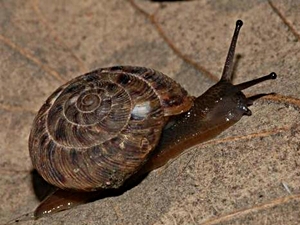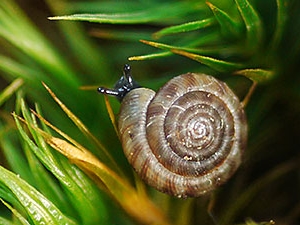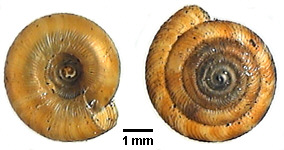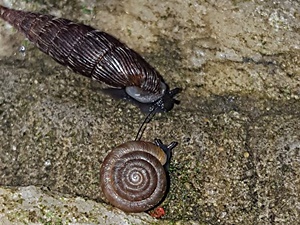
Eastern forest snail (Anguispira alternata), a considerably lar-
ger relative of disc snails (Patulidae family) from America.
Picture: Harlan Ratcliff, Poweshiek Skipper Project.
 Eastern forest snail (Anguispira alternata), a considerably lar- ger relative of disc snails (Patulidae family) from America. Picture: Harlan Ratcliff, Poweshiek Skipper Project. |
Class:
Gastropoda
![]() Subclass:
Pulmonata
Subclass:
Pulmonata
![]() Superorder:
Eupulmonata
Superorder:
Eupulmonata
![]() Order:
Stylommatophora
Order:
Stylommatophora
![]() Suborder:
Sigmurethra
Suborder:
Sigmurethra
![]() Infraorder:
Achatinoinei
Infraorder:
Achatinoinei
![]() Superfamily:
Punctoidea
Superfamily:
Punctoidea
![]() Family:
Patulidae Tryon 1866
Family:
Patulidae Tryon 1866
![]() Source: Mollbase auf
http://www.mollbase.de/list/.
Source: Mollbase auf
http://www.mollbase.de/list/.
The discus snails (Patulidae), of which three species are native to Europe, are small: But with a shell width of 5 to 7 mm, in nature they can still easily be discovered on logs and in the undergrowth with a trained eye. Discus snails have their name, because their shell is roughly lentil-shaped like a discus.
The most common discus snail, and the only one native to the British Isles, is the rounded snail (Discus rotundatus). It is different from its relative, the brown discus snail (Discus ruderatus) by a flatter, more prominently keeled shell, whose surface shows clearer ribs and besides characteristic red-brownish stripes crossing the whorls in regular distances.
 Rounded disc snail (Discus rotundatus). Picture: © Stefan Haller (schneckenfoto.ch). |
|
 Picture: Helmut Nisters (The castle of Ambras). |
![]() Picture of Discus rotundatus by Stefan Haller.
Picture of Discus rotundatus by Stefan Haller.
Dimensions: W: 5.5 - 7 mm; N: 5½ - 6. (Abbreviations).
Discus rotundatus lives in humid, sheltered habitats of different kinds: In forests it can be found in the undergrowth and under stones, between herbs, in the grass and on logs lying in the forest. In gardens they are often found under garden waste. In Switzerland, in Grisons, Discus rotundatus climbs to an altitude of 2700 m (about 8100 ft.) above sea-level.
 Rounded disc snail (Discus rotundatus). [RN] |
|
 Rounded disc snail (Discus rotundatus, bottom) and common door snail (Alinda biplicata, top). Picture: Martina Eleveld. |
The rounded snail is common almost everywhere in Europe, the distribution area stretches as far north as southern Scandinavia. There it has been distributed by man (anthropogenically), occurring even exclusively in gardens and greenhouses in Finland. In Hungary, Discus rotundatus is found in nature only in mountainous areas, elsewhere it lives in greenhouses.
Systematics
The discus snail family (Patulidae) is placed in the superfamily Punctoidea and so among the terrestrial pulmonate snails (Stylommatophora). There is, though, some disagreement about what the correct way would be to name the family scientifically.
The scientific name Patulidae Tryon 1866 is based on a younger synonym of Discus Fitzinger, 1833, Patula Held 1837, but as such is older and therefore more valid than Discidae Thiele 1931 and so is stated as the correct scientific name by CLECOM and Mollbase.
In older publications, the genus Discus is placed in the family Endodontidae Pilsbry 1895, a classification, which is not supported by the current scientific opinion. Today, Patulidae and Endodontidae are placed separately as independent families.
Literature
Links:
Complete species list for Europe
Source:
CLECOM,
as of June 2008)
Patulidae Tryon, 1866
Discus Fitzinger, 1833
Discus Fitzinger, 1833
Discus (Discus) ruderatus ruderatus (W. Hartmann, 1821)
Gonyodiscus Fitzinger, 1833
Discus (Gonyodiscus) rotundatus rotundatus (O.F. Müller, 1774) (Only species native to the British Isles)
Discus (Gonyodiscus) perspectivus (Megerle von Mühlfeld, 1816)